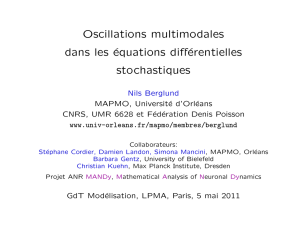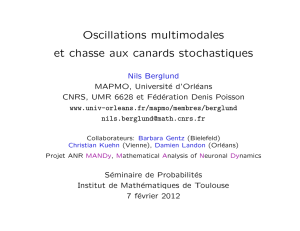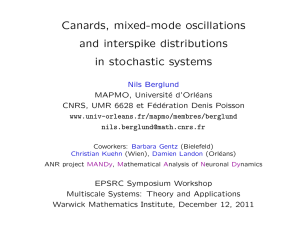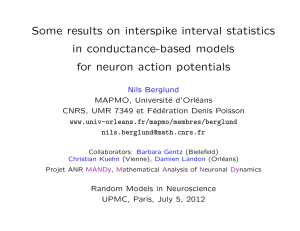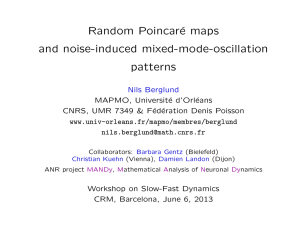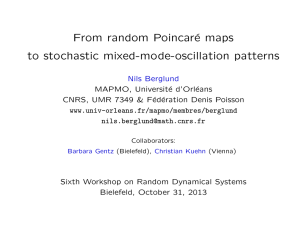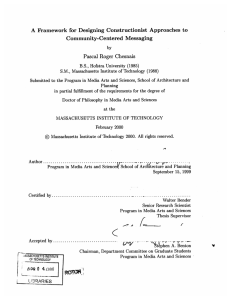Chasse aux canards en environnement bruit´ e
advertisement
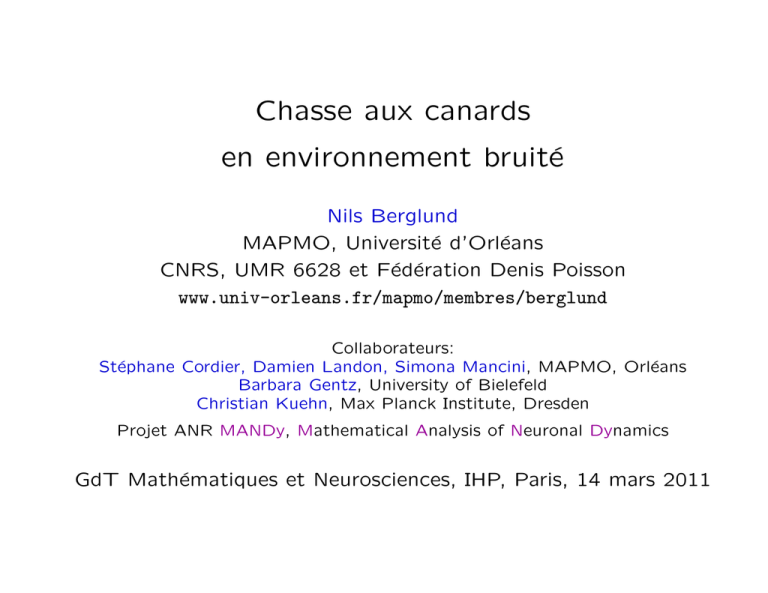
Chasse aux canards
en environnement bruité
Nils Berglund
MAPMO, Université d’Orléans
CNRS, UMR 6628 et Fédération Denis Poisson
www.univ-orleans.fr/mapmo/membres/berglund
Collaborateurs:
Stéphane Cordier, Damien Landon, Simona Mancini, MAPMO, Orléans
Barbara Gentz, University of Bielefeld
Christian Kuehn, Max Planck Institute, Dresden
Projet ANR MANDy, Mathematical Analysis of Neuronal Dynamics
GdT Mathématiques et Neurosciences, IHP, Paris, 14 mars 2011
Oscillations in natural systems
Belousov-Zhabotinsky reaction [Hudson 79]
Stellate cells [Dickson 00]
Mean temperature based on ice core measurements [Johnson et al 01]
1
Oscillations in natural systems
Belousov-Zhabotinsky reaction [Hudson 79]
Stellate cells [Dickson 00]
. Deterministic models reproducing these oscillations exist
and have been abundantly studied
They often involve singular perturbation theory
. We want to understand the effect of noise
on oscillatory patterns
1-a
Example: Van der Pol oscillator
1 x3
ẋ = y + x − 3
ẏ = −εx
t7→εt
⇐⇒
x00 +ε−1/2(x2 −1)x0 +x = 0
1 x3
εẋ = y + x − 3
ẏ = −x
2
x00 +ε−1/2(x2 −1)x0 +x = 0
Example: Van der Pol oscillator
1 x3
ẋ = y + x − 3
ẏ = −εx
y
t7→εt
⇐⇒
ẏ = 0
ẏ = −x
y
ε→0
3
x
ẋ = y + x − 1
3
1 x3
εẋ = y + x − 3
⇐⇒
/
ε→0
3)
y = −(x − 1
x
3
ẏ = −x
x
⇒ ẋ =
1 − x2
2-a
x00 +ε−1/2(x2 −1)x0 +x = 0
Example: Van der Pol oscillator
1 x3
ẋ = y + x − 3
t7→εt
⇐⇒
ẏ = −εx
y
1 x3
εẋ = y + x − 3
ẏ = −x
y
ε→0
3
x
ẋ = y + x − 1
3
⇐⇒
/
ẏ = 0
ε→0
3)
y = −(x − 1
x
3
ẏ = −x
x
⇒ ẋ =
2
1
−
x
x
x
y
y
2-b
x00 +ε−1/2(x2 −1)x0 +x = 0
Example: Van der Pol oscillator
1 x3
ẋ = y + x − 3
t7→εt
⇐⇒
ẏ = −εx
3
εẋ=y + x − 1
x
3
ẏ=−x
x
y
Relaxation oscillations
x
x
y
y
2-c
Effect of noise on the Van der Pol oscillator
#
3
xt
dxt = yt + xt −
dt + σ dWt
"
3
dyt = −εxt dt
3
Effect of noise on the Van der Pol oscillator
#
3
xt
dxt = yt + xt −
dt + σ dWt
"
3
dyt = −εxt dt
Theorem [B & Gentz 2006]
√
• σ < ε : Cycles comparable to deterministic ones
2
−ε/σ
with probability 1 − O(e
)
√
• σ > ε : Cycles are smaller, by O(σ 4/3), than deterministic cycles, with probability
2 /ε|log σ|
−σ
1 − O(e
)
3-a
Neuron
. Single neuron communicates by generating action potential
. Excitable: small change in parameters yields spike generation
. May display Mixed-Mode Oscillations (MMOs) and Relaxation
Oscillations
4
Conductance-based models for membrane potential
Hodgkin–Huxley model (1952)
C v̇ = −
X
i
α
β
ḡiϕi i χi i (v − vi∗)
τϕ,i(v)ϕ̇i = −(ϕi − ϕ∗i (v))
τχ,i(v)χ̇i = −(χi − χ∗i (v))
voltage
activation
inactivation
. i ∈ {Na+, K+, . . . } describes different types of ion channels
. ϕ∗i (v), χ∗i (v) sigmoı̈dal functions, e.g. tanh(av + b)
5
Conductance-based models for membrane potential
Hodgkin–Huxley model (1952)
C v̇ = −
X
i
α
β
ḡiϕi i χi i (v − vi∗)
τϕ,i(v)ϕ̇i = −(ϕi − ϕ∗i (v))
τχ,i(v)χ̇i = −(χi − χ∗i (v))
voltage
activation
inactivation
. i ∈ {Na+, K+, . . . } describes different types of ion channels
. ϕ∗i (v), χ∗i (v) sigmoı̈dal functions, e.g. tanh(av + b)
For C/ḡi τx,i: slow–fast systems of the form
εv̇= f (v, w)
ẇi= gi(v, w)
5-a
Conductance-based models for membrane potential
Fitzhugh–Nagumo model (1962)
εẋ = x − x3 + y
ẏ = α − βx − γy
= √1 + δ − x
3
The canard (french duck) phenomenon
[J.-L. Callot, F. Diener, M. Diener (1978), E. Benoı̂t (1981), . . . ]
ε = 0.05
α=
β
γ
δ1
δ2
δ3
δ4
√1
3
+δ
=1
=0
= −0.003
= −0.003765458
= −0.003765459
= −0.005
6
Conductance-based models for membrane potential
Fitzhugh–Nagumo model (1962)
εẋ = x − x3 + y
ẏ = α − βx − γy
= √1 + δ − x
3
The canard (french duck) phenomenon
[J.-L. Callot, F. Diener, M. Diener (1978), E. Benoı̂t (1981), . . . ]
ε = 0.05
α=
β
γ
δ1
δ2
δ3
δ4
√1
3
+δ
=1
=0
= −0.003
= −0.003765458
= −0.003765459
= −0.005
y
δ3
δ4
δ2
δ1
x
6-a
Conductance-based models for membrane potential
Fitzhugh–Nagumo model (1962)
εẋ = x − x3 + y
ẏ = α − βx − γy
= √1 + δ − x
3
The canard (french duck) phenomenon
[J.-L. Callot, F. Diener, M. Diener (1978), E. Benoı̂t (1981), . . . ]
ε = 0.05
α=
β
γ
δ1
δ2
δ3
δ4
√1
3
+δ
=1
=0
= −0.003
= −0.003765458
= −0.003765459
= −0.005
6-b
The canard (french duck) phenomenon
Normal form near fold point
εẋ = y − x2
(+ higher-order terms)
ẏ = δ − x
0.5
ts
y
0.5
(a)
0.3
0.1
−0.1
−0.7
Cǫa
Cǫr
−0.3
0.1
0.5
0.5
(b)
0.3
0.3
0.1
0.1
C0
0.7
−0.1
−0.7
−0.3
0.1
0.5
0.7
−0.1
−0.7
(c)
Cǫr
Cǫa
−0.3
0.1
0.5
0.7
x
6-c
Folded node singularity
Normal form [Benoı̂t, Lobry ’82, Szmolyan, Wechselberger ’01]:
ẋ = y − x2
ẏ = −(µ + 1)x − z
µ
ż =
2
(+ higher-order terms)
7
Folded node singularity
Normal form [Benoı̂t, Lobry ’82, Szmolyan, Wechselberger ’01]:
ẋ = y − x2
ẏ = −(µ + 1)x − z
µ
ż =
2
(+ higher-order terms)
y
C0r
C0a
L
x
z
7-a
Folded node singularity
Theorem [Benoı̂t, Lobry ’82, Szmolyan, Wechselberger ’01]:
For 2k + 1 < µ−1 < 2k + 3, the system admits k canard solutions
The j th canard makes (2j + 1)/2 oscillations
Mixed-mode oscillations
(MMOs)
Picture: Mathieu Desroches
7-b
Effect of noise
1
σ
(1)
2
dxt = (yt − xt ) dt + √ dWt
ε
ε
(2)
dyt = [−(µ + 1)xt − zt] dt + σ dWt
µ
dzt = dt
2
• Noise smears out small amplitude oscillations
• Early transitions modify the mixed-mode pattern
8
Covariance tubes
det det
Linearized stochastic equation around a canard (xdet
t , yt , zt )
dζt = A(t)ζt dt + σ dWt
ζt = U (t)ζ0 + σ
Z t
0
U (t, s) dWs
A(t) =
−2xdet
t
1
−(1+µ) 0
(U (t, s) : principal solution of U̇ = AU )
Gaussian process with covariance matrix
Cov(ζt) = σ 2V (t)
V (t) = U (t)V (0)U (t)−1+
Z t
0
U (t, s)U (t, s)T ds
9
Covariance tubes
det det
Linearized stochastic equation around a canard (xdet
t , yt , zt )
dζt = A(t)ζt dt + σ dWt
ζt = U (t)ζ0 + σ
Z t
0
U (t, s) dWs
A(t) =
−2xdet
t
1
−(1+µ) 0
(U (t, s) : principal solution of U̇ = AU )
Gaussian process with covariance matrix
V (t) = U (t)V (0)U (t)−1+
Cov(ζt) = σ 2V (t)
Z t
0
U (t, s)U (t, s)T ds
Covariance tube :
B(h) =
det
−1
det det
2
h(x, y) − (xdet
t , yt ), V (t) [(x, y) − (xt , yt )]i < h
n
o
Theorem [B, Gentz, Kuehn 2010]
Probability of leaving covariance tube before time t (with zt 6 0) :
2 /2σ 2
P τB(h) < t 6 C(t) e−κh
n
o
9-a
9-b
Covariance tubes
Theorem [B, Gentz, Kuehn 2010]
Probability of leaving covariance tube before time t (with zt 6 0) :
2 /2σ 2
P τB(h) < t 6 C(t) e−κh
n
o
Sketch of proof :
. (Sub)martingale : {Mt }t>0 , E{Mt |Ms } = (>)Ms for t > s > 0
n
o 1
. Doob’s submartingale inequality : P sup Mt > L 6 E[MT ]
L
06t6T
10
Covariance tubes
Theorem [B, Gentz, Kuehn 2010]
Probability of leaving covariance tube before time t (with zt 6 0) :
2 /2σ 2
P τB(h) < t 6 C(t) e−κh
n
o
Sketch of proof :
. (Sub)martingale : {Mt }t>0 , E{Mt |Ms } = (>)Ms for t > s > 0
n
o 1
. Doob’s submartingale inequality : P sup Mt > L 6 E[MT ]
L
06t6T
Z t
. Linear equation : ζt = σ
U (t, s) dWs is no martingale
0
but can be approximated by martingale on small time intervals
. exp{γhζt , V (t)−1 ζt i} approximated by submartingale
. Doob’s inequality yields bound on probability of leaving B(h) during small
time intervals. Then sum over all time intervals
10-a
Covariance tubes
Theorem [B, Gentz, Kuehn 2010]
Probability of leaving covariance tube before time t (with zt 6 0) :
2 /2σ 2
P τB(h) < t 6 C(t) e−κh
n
o
Sketch of proof :
. (Sub)martingale : {Mt }t>0 , E{Mt |Ms } = (>)Ms for t > s > 0
n
o 1
. Doob’s submartingale inequality : P sup Mt > L 6 E[MT ]
L
06t6T
Z t
. Linear equation : ζt = σ
U (t, s) dWs is no martingale
0
but can be approximated by martingale on small time intervals
. exp{γhζt , V (t)−1 ζt i} approximated by submartingale
. Doob’s inequality yields bound on probability of leaving B(h) during small
time intervals. Then sum over all time intervals
. Nonlinear equation : dζt = A(t)ζt dt + b(ζt , t) dt + σ dWt
Z t
Z t
ζt = σ
U (t, s) dWs +
U (t, s)b(ζs , s) ds
0
0
Second integral can be treated as small perturbation for t 6 τB(h)
10-b
Small-amplitude oscillations and noise
One shows that for z = 0
. The distance between the kth and k + 1st canard
2
has order e−(2k+1) µ
. The section of B(h) is close to circular with radius µ−1/4h
11
Small-amplitude oscillations and noise
One shows that for z = 0
. The distance between the kth and k + 1st canard
2
has order e−(2k+1) µ
. The section of B(h) is close to circular with radius µ−1/4h
Sketch of proof :
. Dynamic diagonalization of equation linearized around central (“weak”)
canard
. V (t) = σ −2 Cov(ζt ) satisfies fast-slow equation
dV
= A(z)V + V A(z)T + 1l
dz
which can be studied by singular perturbation theory.
Note : Hopf bifurcation at z = 0 !
µ
11-a
Small-amplitude oscillations and noise
One shows that for z = 0
. The distance between the kth and k + 1st canard
2
has order e−(2k+1) µ
. The section of B(h) is close to circular with radius µ−1/4h
Corollary
Let
2
σk (µ) = µ1/4 e−(2k+1) µ
Canards with 2k+1
oscillations
4
become indistinguishable from
noisy fluctuations for σ > σk (µ)
11-b
Small-amplitude oscillations and noise
One shows that for z = 0
. The distance between the kth and k + 1st canard
2
has order e−(2k+1) µ
. The section of B(h) is close to circular with radius µ−1/4h
Corollary
Let
2
σk (µ) = µ1/4 e−(2k+1) µ
Canards with 2k+1
oscillations
4
become indistinguishable from
noisy fluctuations for σ > σk (µ)
11-c
Early transitions
Let D be neighbourhood of size
√
z of a canard for z > 0 (unstable)
Theorem [B, Gentz, Kuehn 2010]
∃κ, C, γ1, γ2 > 0 such that for σ|log σ|γ1 6 µ3/4 probability of leaving
D after zt = z satisfies
P zτD > z 6 C|log σ|γ2 e−κ(z
n
Small for z q
o
2 −µ)/(µ|log σ|)
µ|log σ|/κ
12
Early transitions
Let D be neighbourhood of size
√
z of a canard for z > 0 (unstable)
Theorem [B, Gentz, Kuehn 2010]
∃κ, C, γ1, γ2 > 0 such that for σ|log σ|γ1 6 µ3/4 probability of leaving
D after zt = z satisfies
P zτD > z 6 C|log σ|γ2 e−κ(z
n
Small for z q
o
2 −µ)/(µ|log σ|)
µ|log σ|/κ
Sketch of proof :
√
. Escape from neighbourhood of size σ|log σ|/ z :
compare with linearized equation on small time intervals + Markov property
√
√
. Escape from annulus σ|log σ|/ z 6 kζk 6 z :
use polar coordinates and averaging
. To combine the two regimes : use Laplace transforms
12-a
Early transitions
Let D be neighbourhood of size
√
z of a canard for z > 0 (unstable)
Theorem [B, Gentz, Kuehn 2010]
∃κ, C, γ1, γ2 > 0 such that for σ|log σ|γ1 6 µ3/4 probability of leaving
D after zt = z satisfies
P zτD > z 6 C|log σ|γ2 e−κ(z
n
Small for z q
o
2 −µ)/(µ|log σ|)
µ|log σ|/κ
12-b
Further work
. Better understanding of distribution of noise-induced transitions
. Effect on mixed-mode pattern in conjunction with global return mechanism
13
Further work
. Better understanding of distribution of noise-induced transitions
. Effect on mixed-mode pattern in conjunction with global return mechanism
13-a
References
N.B. and Barbara Gentz, Noise-induced phenomena in slow-fast dynamical systems, A
sample-paths approach, Springer, Probability
and its Applications (2006)
N.B. and Barbara Gentz, Stochastic dynamic
bifurcations and excitability, in C. Laing and
G. Lord, (Eds.), Stochastic methods in Neuroscience, p. 65-93, Oxford University Press
(2009)
N.B., Barbara Gentz and Christian Kuehn,
Hunting French Ducks in a Noisy Environment,
hal-00535928, submitted (2010)
14
Noise-induced MMOs
[D. Landon, PhD thesis, in progress]
FitzHugh–Nagumo, normal form near bifurcation point:
dxt= (yt − x2
t ) dt + σ dWt
dyt= ε(δ − xt) dt
√
. δ > ε: equilibrium (δ, δ 2) is a node, effectively 1D problem
• σ δ 3/2: rare spikes, approx. exponential interspike times
• σ δ 3/2: repeated spikes
√
δ < ε: equilibrium (δ, δ 2) is a focus. Two-dimensional problem
15
Noise-induced MMOs
[D. Landon, PhD thesis, in progress]
FitzHugh–Nagumo, normal form near bifurcation point:
dxt= (yt − x2
t ) dt + σ dWt
dyt= ε(δ − xt) dt
√
. δ > ε: equilibrium (δ, δ 2) is a node, effectively 1D problem
• σ δ 3/2: rare spikes, approx. exponential interspike times
• σ δ 3/2: repeated spikes
√
. δ < ε: equilibrium (δ, δ 2) is a focus. Two-dimensional problem
15-a
Noise-induced MMOs
[D. Landon, PhD thesis, in progress]
Conjectured bifurcation diagram [Muratov and Vanden Eijnden (2007)] :
σ
ε3/4
σ = δ 3/2
σ = (δε)1/2
σ = δε1/4
ε1/2
δ
16
Noise-induced MMOs
[D. Landon, PhD thesis, in progress]
Conjectured bifurcation diagram [Muratov and Vanden Eijnden (2007)] :
σ
ε3/4
σ = δ 3/2
σ = (δε)1/2
σ = δε1/4
ε1/2
δ
Work in progress :
. Prove bifurcation diagram is correct
. Characterize interspike time statistics and spike train statistics
. Characterize distribution of mixed-mode patterns
16-a

